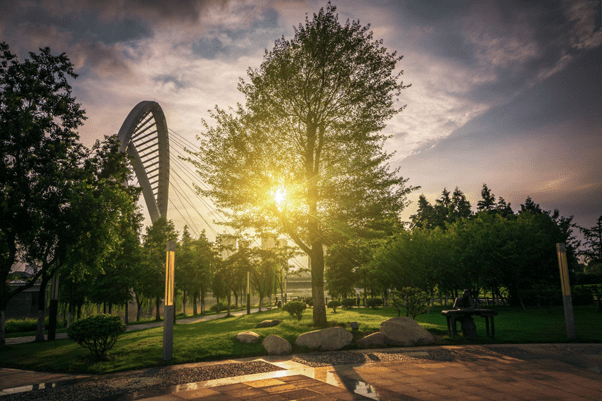The fast urbanization is taking its toll on urban environments. According to the American Environmental Protection Agency, the annual air temperature of a city with 1 million people is up to 3 degrees Celsius warmer than that in greener surroundings. The lack of public green spaces, such as parks, tree alleys, and gardens with local and native greenery is causing a vicious circle that is seemingly impossible to get out.
Namely, as we focus on adding as many buildings with as much concrete and glass as possible, we are also forcing people in those buildings to use as much air conditioning as possible. Modern materials absorb and re-emit heat, making walks down the streets unbearable. This leads to increased use of cars and increased levels of CO2, which, you guessed it, increases the air temperature.
Fortunately, architects and urban landscapers are starting to see the negative consequences of the decades-long neglect of green spaces in urban environments.
Green Cities are the Future
The concept of green urbanism is not new. In the United States, it originates from the late 19th century, although the concept of creating free, green public spaces was nothing new to Europe. According to some sources, the Sad Janka Kráľa in Bratislava was the first public park in the world, opened in the 1770s.
Green urbanism aims to make cities more sustainable while increasing the quality of life of its residents at the same time. It may include different concepts, such as:
- Renewable energy sources;
- Eco-friendly practices to decrease the climate impact and carbon footprint;
- Sustainable transport;
- Effective landscaping with native plants;
- Local supply chains;
- Urban gardening;
- Water efficiency.
Main Goal of Green Urbanism
One of the main goals of green urbanism in the 21st century is to lower temperatures naturally, by reducing energy consumption, increasing the number of green areas in the city and improving the overall air quality. The change is seeded in the implementation of green roofs, vertical gardens, eco-friendly, yet insulating materials, and raising awareness of the dangers of urban heat islands.
Challenges and Opportunities of Green Urbanism
The transition to green cities is not an easy fit that can be completed in a year. It takes careful planning, long-term thinking, and taking into account finances and all the technical complexities.
The Potential Impact of Digital Technologies on the Development of Green Cities
The use of digital technologies is often perceived as a solid method to lead the community towards greener practices. Let’s explain it by using the example of online casinos.
Online casinos are digital platforms. As such, they have a lower environmental footprint compared to traditional brick-and-mortar establishments. They eliminate many factors that make our cities often unbearable in the heat. Online casinos such help avoid light pollution, traffic congestion, and cooling and heating of large premises. Free access to the platform https://gryonline2.pl/ gives users the opportunity to receive bonuses, play slot machines with virtual currency and get acquainted with new casinos without leaving the comfort of their home.
Examples of Successful Green City Projects
It is time to look at some green city examples and see how this problem was tackled in some of the biggest cities in the world.
Singapore As a Model of Urban Greenery
If you have ever been to Singapore, you know that the heat and humidity are intense there:
- 99% of all private condominiums are air-conditioned;
- The constant use of air-conditioning raised the average temperature by 0.5 in the last decade;
- In 2019, it was published that the city is heating two times faster than other big cities with similar infrastructure.
That was a wake-up call, and today, Singapore is often referred to as the “Garden City”. The city-state is now putting effort into blending nature with urban development. Additionally, Singapore’s government mandates the incorporation of greenery in building designs, ensuring that urban development progresses in harmony with environmental conservation.
Copenhagen Leads in Climate Adaptation
By 2025, Copenhagen wants to be the first carbon-neutral capital in history. The new strategy is focused on sustainable public transportation, predominantly bicycle infrastructure. The campaign was so successful that 49% of citizens already use bikes as their preferred way of commute, compared to 35% only a decade ago. With an investment of 40 EUR per capita, the city changed the way it thinks and works!
Melbourne’s Urban Forest Strategy
Australian heat is no joke, yet not everyone takes it seriously. As the need for real estate increases, the green areas in the city are being reduced to the bare minimum. According to stats, Melbourne has lost almost 2000 hectares of tree cover in the past five years, and now it is trying to put an end to deforestation!
Melbourne’s Urban Forest Strategy plans to increase the city’s green space by planting 3,000 trees each year. This initiative not only addresses urban heat but also enhances biodiversity and improves air quality for generations to come.
Slow, But Necessary Change
Going green is a steady process that must consider existing infrastructure as well as future development, which makes it incredibly challenging. While it is impossible to tear down all inefficient buildings, many practices can be implemented almost instantly. Setting higher energy standards for future builds, announcing car-free zones, creating bike lanes, and even encouraging sustainable tourism are some of the easiest things any community can do to avoid the devastating consequences of rapid urbanism. Development with no plan or structure is, after all, a certain way to ruin.
Read more from techbullion




































